TOYOTA COROLLA 2023 Workshop Manual
Manufacturer: TOYOTA, Model Year: 2023, Model line: COROLLA, Model: TOYOTA COROLLA 2023Pages: 468, PDF Size: 14.4 MB
Page 51 of 468
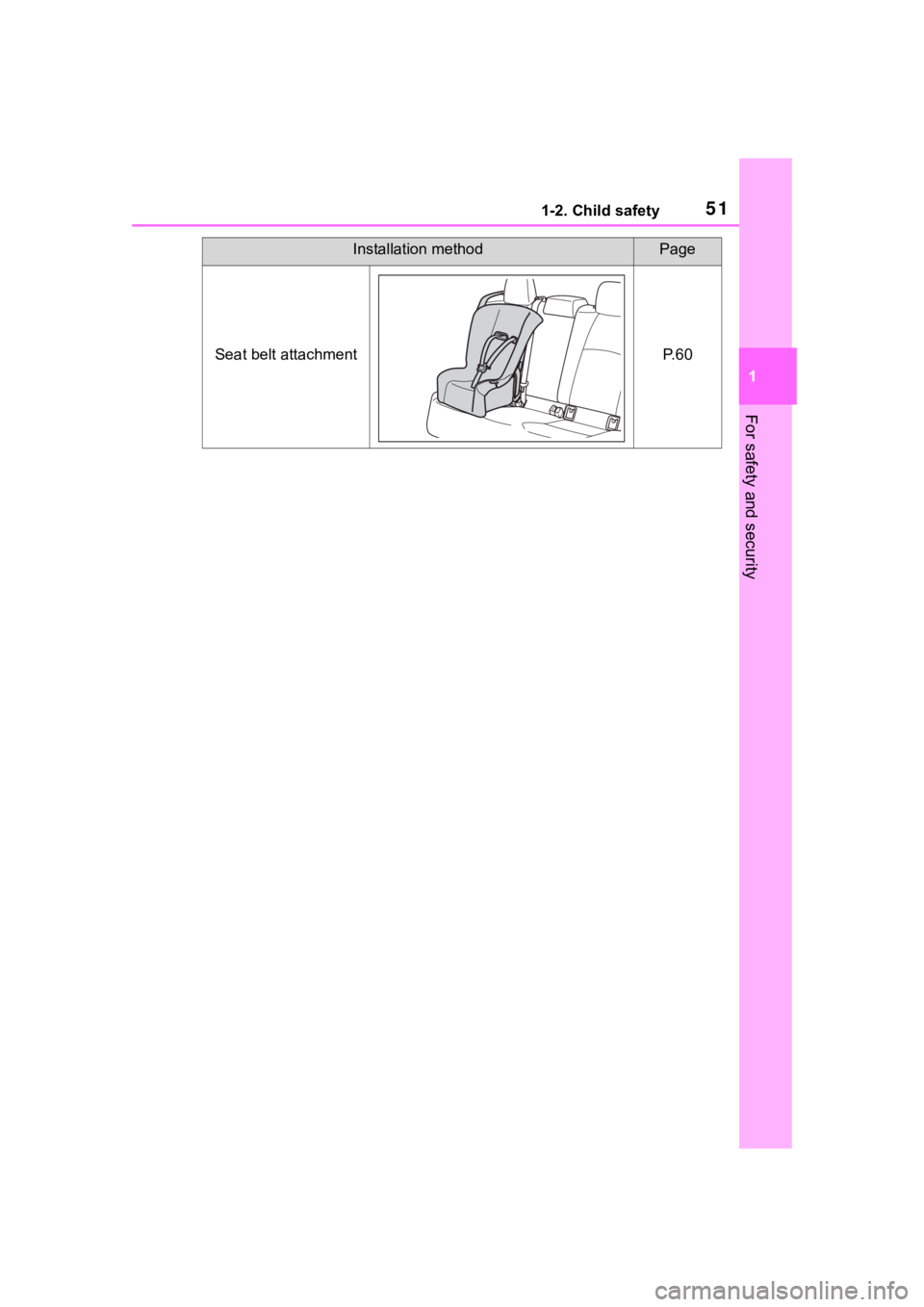
511-2. Child safety
1
For safety and security
Installation methodPage
Seat belt attachmentP. 6 0
Page 52 of 468
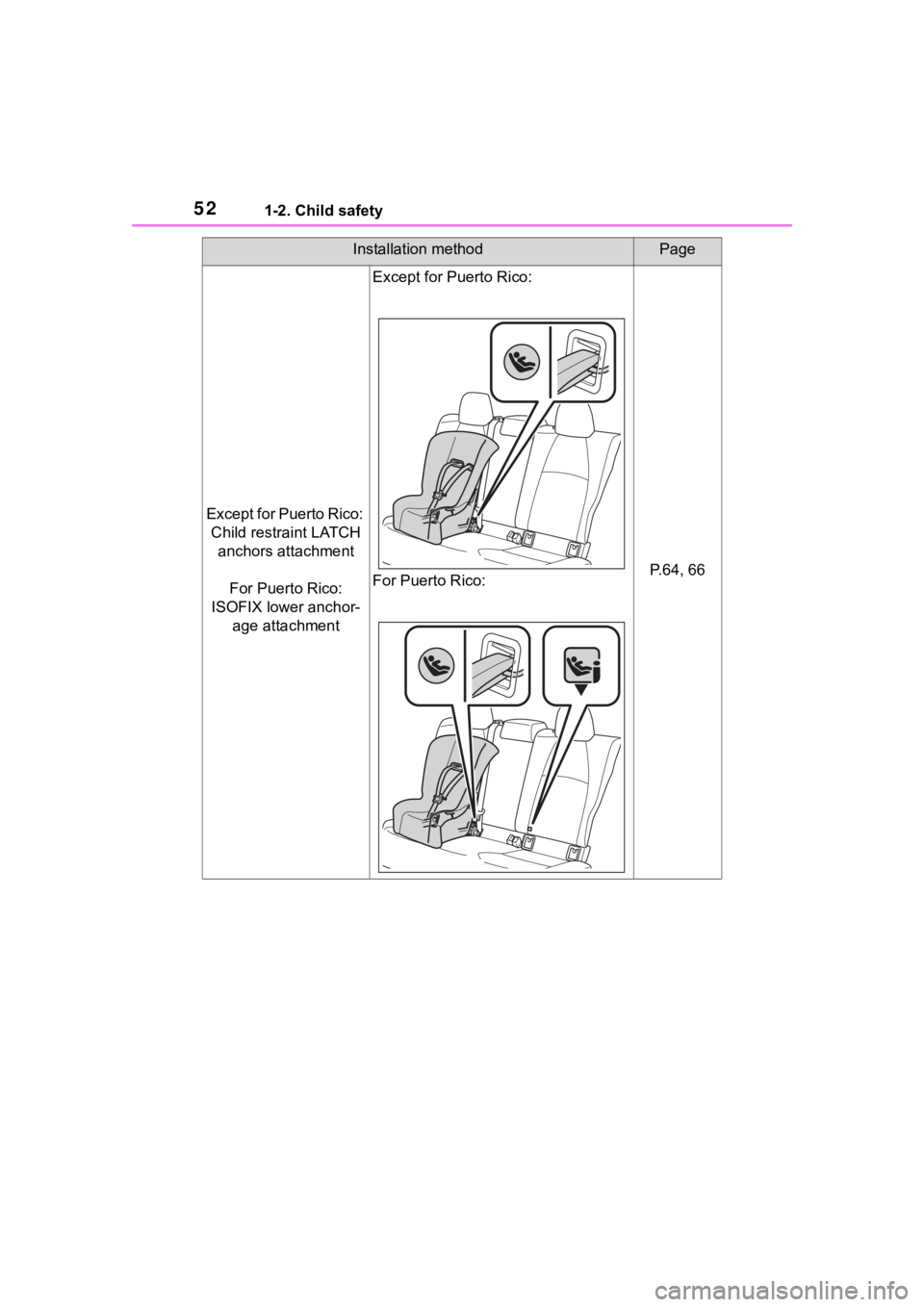
521-2. Child safety
Except for Puerto Rico: Child restraint LATCH anchors attachment
For Puerto Rico:
ISOFIX lower anchor- age attachment
Except for Puerto Rico:
For Puerto Rico:
P.64, 66
Installation methodPage
Page 53 of 468
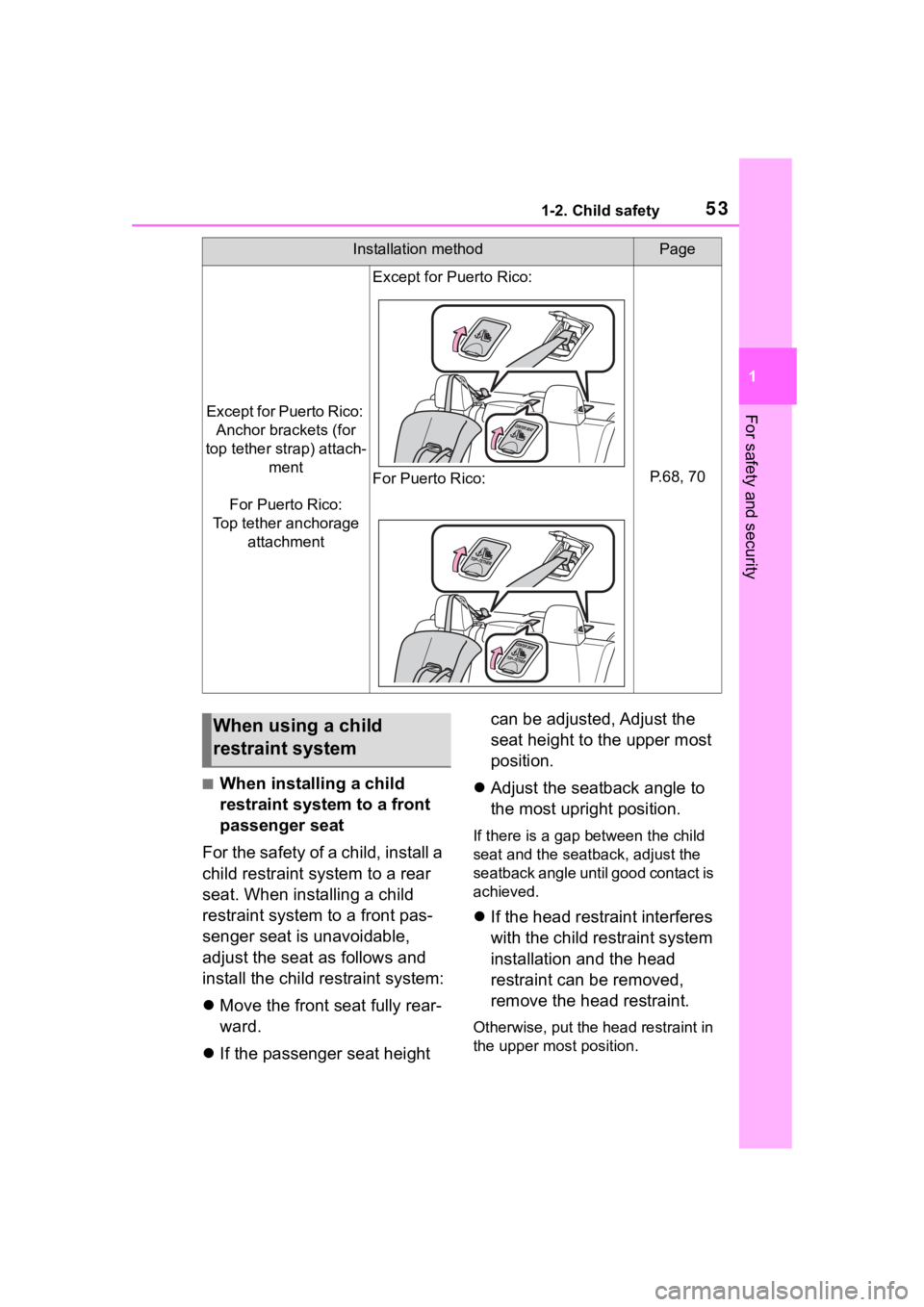
531-2. Child safety
1
For safety and security
■When installing a child
restraint system to a front
passenger seat
For the safety of a child, install a
child restraint system to a rear
seat. When installing a child
restraint system to a front pas-
senger seat is unavoidable,
adjust the seat as follows and
install the child restraint system:
Move the front seat fully rear-
ward.
If the passenger seat height can be adjusted, Adjust the
seat height to the upper most
position.
Adjust the seatback angle to
the most upright position.
If there is a gap between the child
seat and the seatb ack, adjust the
seatback angle until good contact is
achieved.
If the head restraint interferes
with the child restraint system
installation and the head
restraint can be removed,
remove the head restraint.
Otherwise, put the head restraint in
the upper mo st position.
Except for Puerto Rico:
Anchor brackets (for
top tether strap) attach- ment
For Puerto Rico:
Top tether anchorage attachment
Except for Puerto Rico:
For Puerto Rico:
P.68, 70
Installation methodPage
When using a child
restraint system
Page 54 of 468
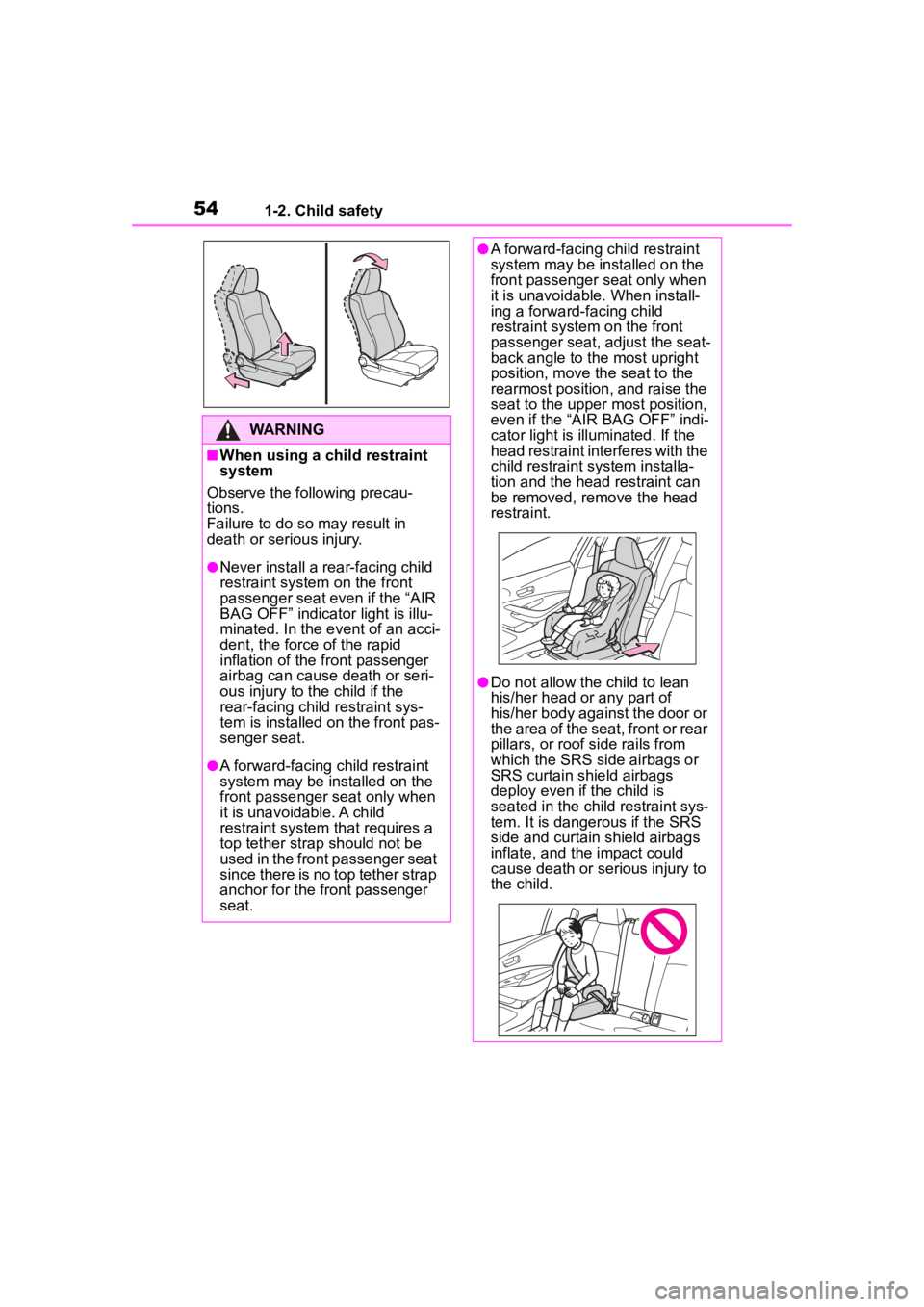
541-2. Child safety
WARNING
■When using a child restraint
system
Observe the following precau-
tions.
Failure to do so m ay result in
death or serious injury.
●Never install a rear-facing child
restraint system on the front
passenger seat even if the “AIR
BAG OFF” indicator light is illu-
minated. In the event of an acci-
dent, the force of the rapid
inflation of the front passenger
airbag can cause death or seri-
ous injury to the child if the
rear-facing child restraint sys-
tem is installed on the front pas-
senger seat.
●A forward-facing child restraint
system may be installed on the
front passenger seat only when
it is unavoidable. A child
restraint system that requires a
top tether strap should not be
used in the front passenger seat
since there is no top tether strap
anchor for the fr ont passenger
seat.
●A forward-facing child restraint
system may be installed on the
front passenger seat only when
it is unavoidable. When install-
ing a forward-facing child
restraint system on the front
passenger seat, adjust the seat-
back angle to the most upright
position, move the seat to the
rearmost position, and raise the
seat to the upper most position,
even if the “AIR BAG OFF” indi-
cator light is illuminated. If the
head restraint interferes with the
child restraint system installa-
tion and the head restraint can
be removed, remove the head
restraint.
●Do not allow th e child to lean
his/her head or any part of
his/her body against the door or
the area of the seat, front or rear
pillars, or roof side rails from
which the SRS side airbags or
SRS curtain shield airbags
deploy even if the child is
seated in the child restraint sys-
tem. It is dangerous if the SRS
side and curtain shield airbags
inflate, and the impact could
cause death or serious injury to
the child.
Page 55 of 468
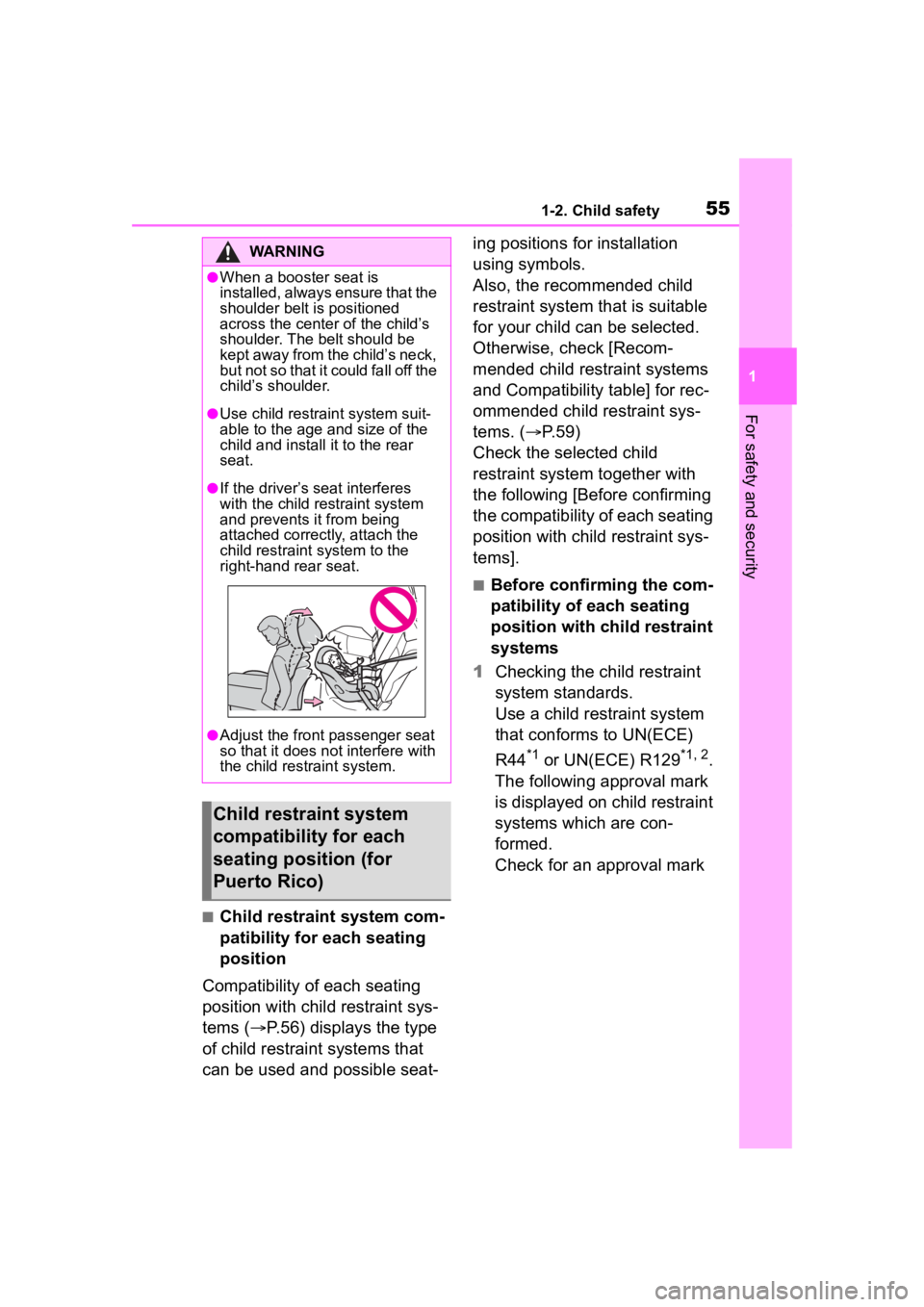
551-2. Child safety
1
For safety and security
■Child restraint system com-
patibility for each seating
position
Compatibility of each seating
position with child restraint sys-
tems ( P.56) displays the type
of child restraint systems that
can be used and possible seat- ing positions for installation
using symbols.
Also, the recommended child
restraint system that is suitable
for your child can be selected.
Otherwise, check [Recom-
mended child restraint systems
and Compatibility table] for rec-
ommended child restraint sys-
tems. (
P.59)
Check the selected child
restraint system together with
the following [Before confirming
the compatibility of each seating
position with child restraint sys-
tems].
■Before confirming the com-
patibility of each seating
position with child restraint
systems
1 Checking the child restraint
system standards.
Use a child restraint system
that conforms to UN(ECE)
R44
*1 or UN(ECE) R129*1, 2.
The following approval mark
is displayed on child restraint
systems which are con-
formed.
Check for an approval mark
WARNING
●When a booster seat is
installed, always ensure that the
shoulder belt is positioned
across the center of the child’s
shoulder. The belt should be
kept away from the child’s neck,
but not so that it could fall off the
child’s shoulder.
●Use child restraint system suit-
able to the age and size of the
child and install it to the rear
seat.
●If the driver’s seat interferes
with the child restraint system
and prevents it from being
attached correctly, attach the
child restraint system to the
right-hand rear seat.
●Adjust the front passenger seat
so that it does no t interfere with
the child restraint system.
Child restraint system
compatibility for each
seating position (for
Puerto Rico)
Page 56 of 468
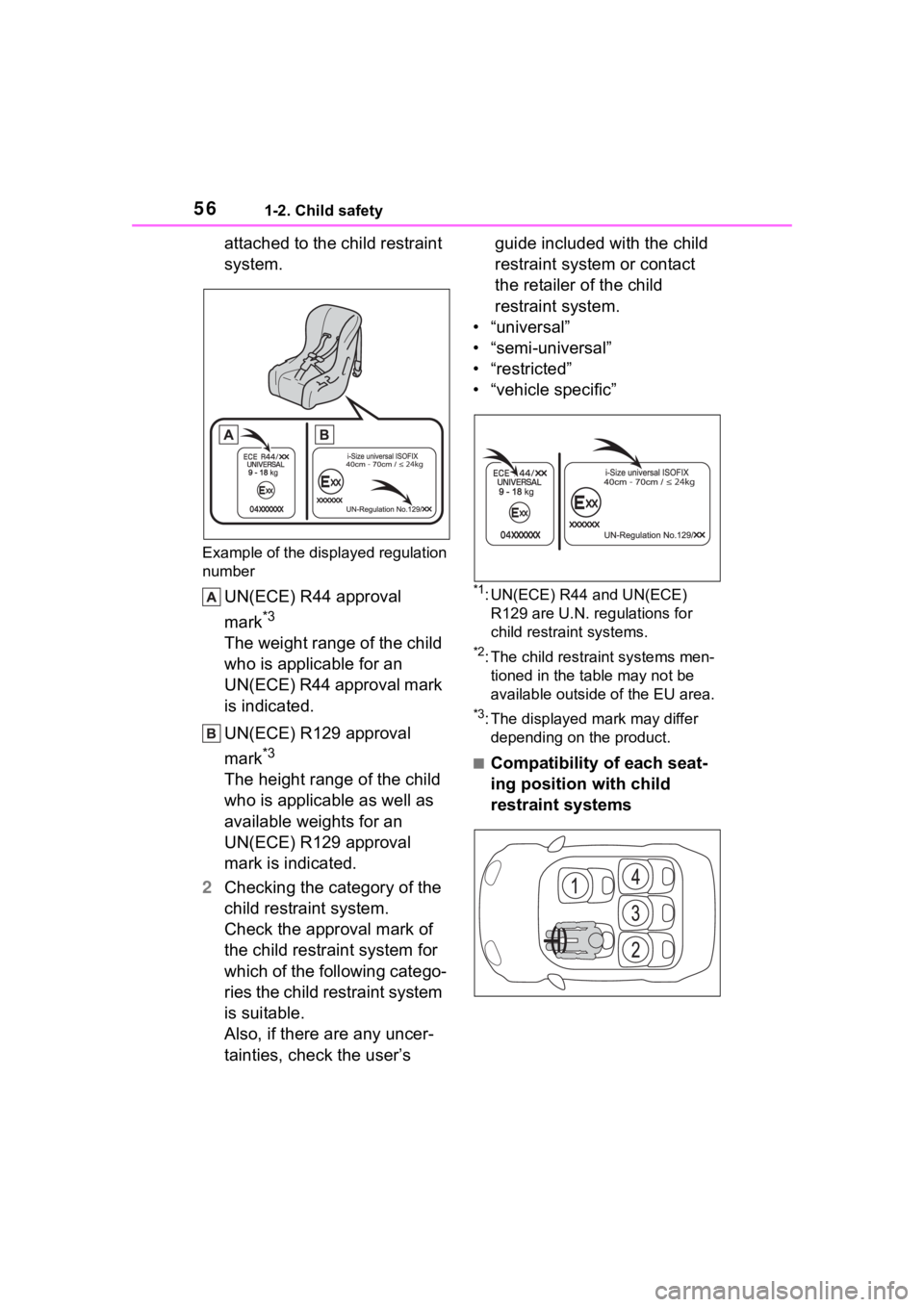
561-2. Child safety
attached to the child restraint
system.
Example of the displayed regulation
number
UN(ECE) R44 approval
mark
*3
The weight range of the child
who is applicable for an
UN(ECE) R44 approval mark
is indicated.
UN(ECE) R129 approval
mark
*3
The height range of the child
who is applicable as well as
available weights for an
UN(ECE) R129 approval
mark is indicated.
2 Checking the category of the
child restraint system.
Check the approval mark of
the child restraint system for
which of the following catego-
ries the child restraint system
is suitable.
Also, if there are any uncer-
tainties, check the user’s guide included with the child
restraint system or contact
the retailer of the child
restraint system.
• “universal”
• “semi-universal”
• “restricted”
• “vehicle specific”
*1: UN(ECE) R44 and UN(ECE) R129 are U.N. regulations for
child restraint systems.
*2: The child restrai nt systems men-
tioned in the table may not be
available outside of the EU area.
*3: The displayed mark may differ depending on the product.
■Compatibility of each seat-
ing position with child
restraint systems
Page 57 of 468
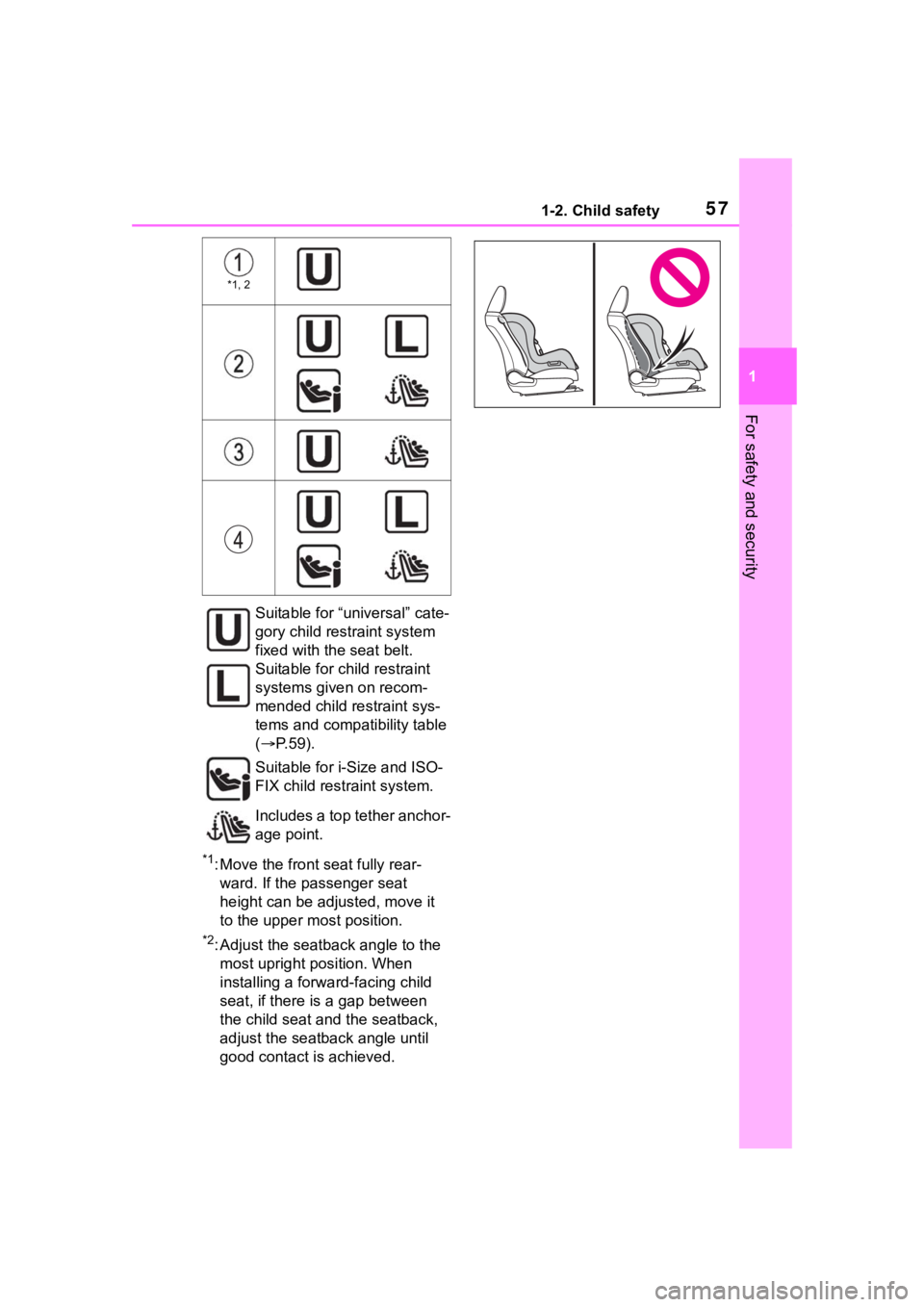
571-2. Child safety
1
For safety and security
*1: Move the front seat fully rear-ward. If the passenger seat
height can be adjusted, move it
to the upper most position.
*2: Adjust the seatback angle to the most upright position. When
installing a forwar d-facing child
seat, if there i s a gap between
the child seat and the seatback,
adjust the seatback angle until
good contact is achieved.
*1, 2
Suitable for “universal” cate-
gory child restraint system
fixed with the seat belt.
Suitable for child restraint
systems given on recom-
mended child restraint sys-
tems and compat ibility table
( P. 5 9 ) .
Suitable for i-Size and ISO-
FIX child restraint system.
Includes a top tether anchor-
age point.
Page 58 of 468
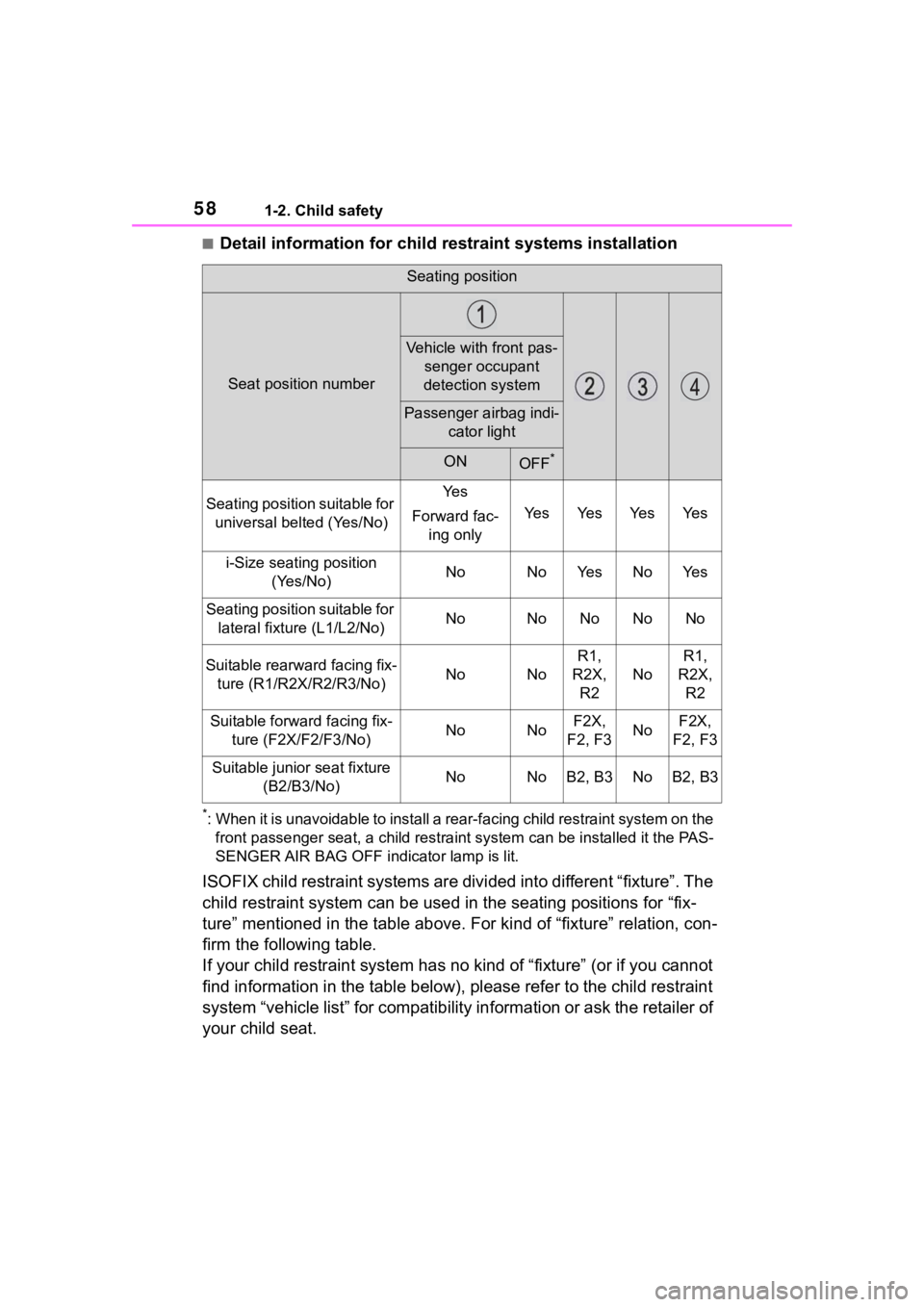
581-2. Child safety
■Detail information for child restraint systems installation
*: When it is unavoidable to install a rear-facing child restraint system on the front passenger seat, a child res traint system can be installed it the PAS-
SENGER AIR BAG OFF indi cator lamp is lit.
ISOFIX child restraint systems a re divided into different “fixture”. The
child restraint system can be used in the seating positions for “fix-
ture” mentioned in the table above. For kind of “fixture” relat ion, con-
firm the following table.
If your child restraint system has no kind of “fixture” (or if you cannot
find information in the table below), please refer to the child restraint
system “vehicle list” for compat ibility information or ask the retailer of
your child seat.
Seating position
Seat position number
Vehicle with front pas- senger occupant
detection system
Passenger airbag indi- cator light
ONOFF*
Seating position suitable for universal belted (Yes/No)Ye s
Forward fac- ing only
Ye sYe sYe sYe s
i-Size seating position (Yes/No)NoNoYe sNoYe s
Seating position suitable for lateral fixture (L1/L2/No)NoNoNoNoNo
Suitable rearward facing fix-ture (R1/R2X/R2/R3/No)NoNo
R1,
R2X, R2
No
R1,
R2X, R2
Suitable forwa rd facing fix-
ture (F2X/F2/F3/No)NoNoF2X,
F2, F3NoF2X,
F2, F3
Suitable junior seat fixture (B2/B3/No)NoNoB2, B3NoB2, B3
Page 59 of 468
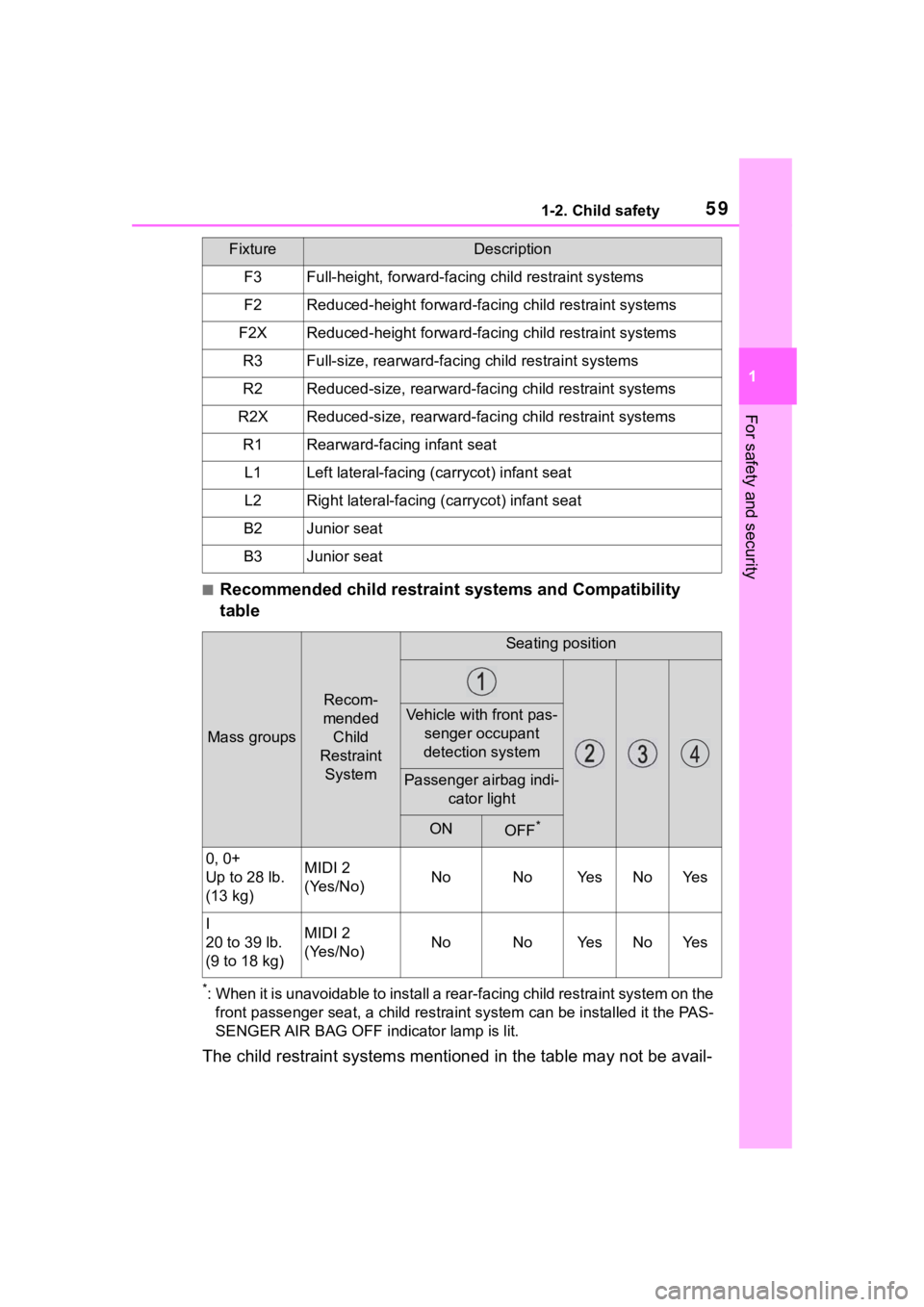
591-2. Child safety
1
For safety and security
■Recommended child restraint systems and Compatibility
table
*: When it is unavoidable to install a rear-facing child restraint system on the front passenger seat, a child res traint system can be installed it the PAS-
SENGER AIR BAG OFF indi cator lamp is lit.
The child restraint systems mentioned in the table may not be avail-
FixtureDescription
F3Full-height, forward-facing child restraint systems
F2Reduced-height forward-faci ng child restraint systems
F2XReduced-height forward-facing child restraint systems
R3Full-size, rearward-facing child restraint systems
R2Reduced-size, rearward-facing child restraint systems
R2XReduced-size, rearward-facing child restraint systems
R1Rearward-facing infant seat
L1Left lateral-facing (carrycot) infant seat
L2Right lateral-facing ( carrycot) infant seat
B2Junior seat
B3Junior seat
Mass groups
Recom-
mended Child
Restraint System
Seating position
Vehicle with front pas- senger occupant
detection system
Passenger airbag indi- cator light
ONOFF*
0, 0+
Up to 28 lb.
(13 kg)MIDI 2
(Yes/No)NoNoYe sNoYe s
I
20 to 39 lb.
(9 to 18 kg)MIDI 2
(Yes/No)NoNoYe sNoYe s
Page 60 of 468
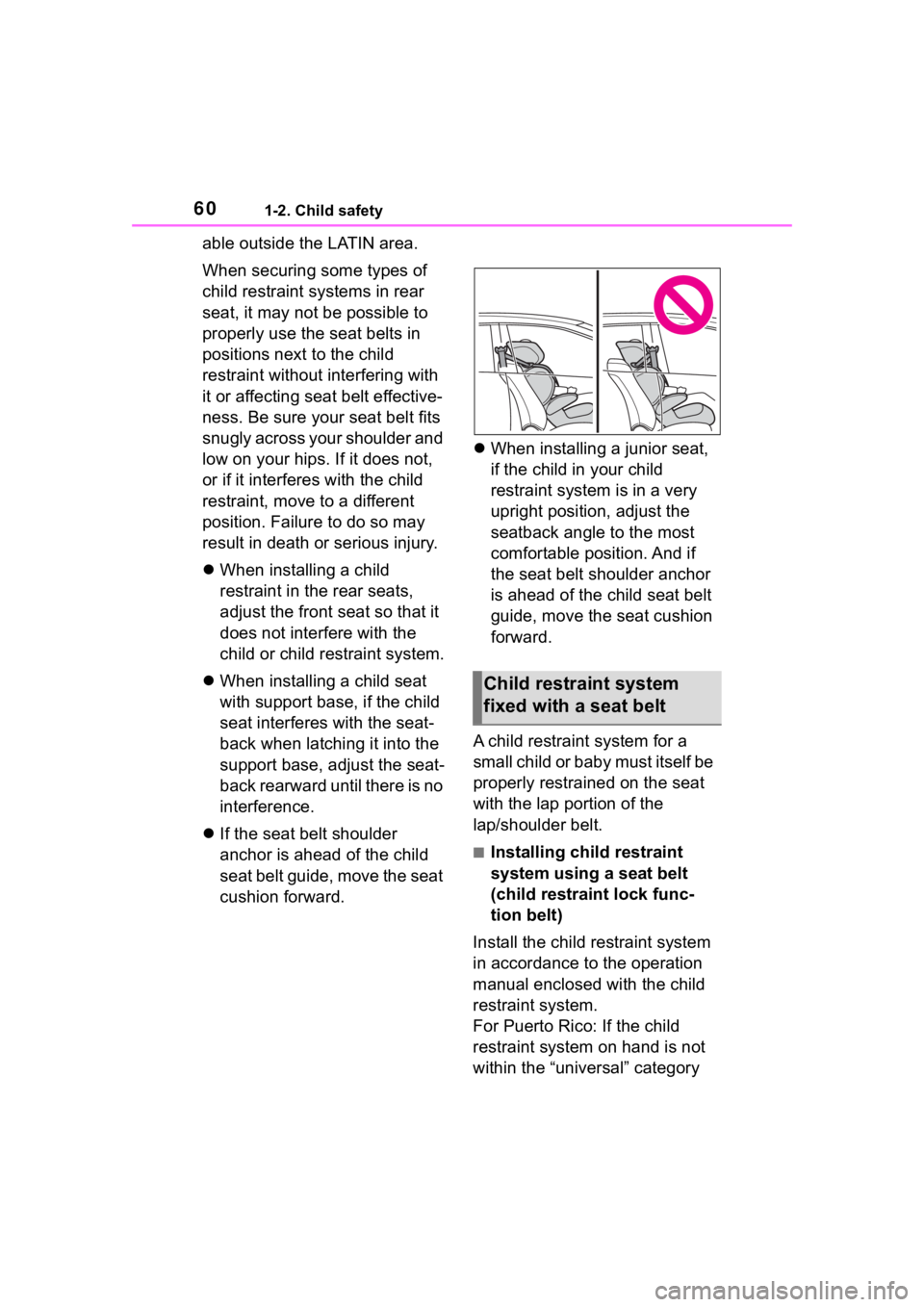
601-2. Child safety
able outside the LATIN area.
When securing some types of
child restraint systems in rear
seat, it may not be possible to
properly use the seat belts in
positions next to the child
restraint without interfering with
it or affecting seat belt effective-
ness. Be sure your seat belt fits
snugly across your shoulder and
low on your hips. If it does not,
or if it interferes with the child
restraint, move to a different
position. Failure to do so may
result in death or serious injury.
When installing a child
restraint in the rear seats,
adjust the front seat so that it
does not interfere with the
child or child restraint system.
When installing a child seat
with support base, if the child
seat interferes with the seat-
back when latching it into the
support base, adjust the seat-
back rearward until there is no
interference.
If the seat belt shoulder
anchor is ahead of the child
seat belt guide, move the seat
cushion forward.
When installing a junior seat,
if the child in your child
restraint system is in a very
upright position, adjust the
seatback angle to the most
comfortable position. And if
the seat belt shoulder anchor
is ahead of the child seat belt
guide, move the seat cushion
forward.
A child restraint system for a
small child or baby must itself be
properly restrained on the seat
with the lap portion of the
lap/shoulder belt.
■Installing child restraint
system using a seat belt
(child restraint lock func-
tion belt)
Install the child restraint system
in accordance to the operation
manual enclosed with the child
restraint system.
For Puerto Rico: If the child
restraint system on hand is not
within the “universal” category
Child restraint system
fixed with a seat belt